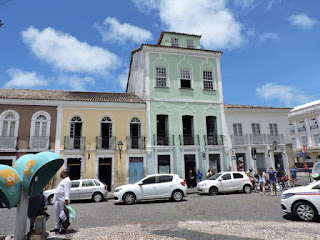Salvador is the capital of Bahia state and commonly referred
to as the cultural capital of Brazil. It was founded in 1549 and quickly became
the first capital of Brazil, and the second most important city in the
Portuguese empire after Lisbon. Portuguese settlers established Salvador as a
major port facilitating the sugar and slave trade, and the city prospered in
the 17th and 18th centuries. A significant portion of the
sugar produced in the northeast and gold and diamonds from the mines in the
southeast passed through the city. Its former status is still evident today in
its enclaves of well restored colonial architecture, cobblestone streets,
colorful mansions and dozens of ornate Baroque churches. Thousands of slaves
brought to Brazil 400 years ago, to work in the sugarcane plantations, makes
Salvador the country’s most Africanized city. The Museu Afro-Brasileira, which
is dedicated to African culture, gives insight into the important impact slaves
had on the development of Salvador. Other holdovers from the slave trade range
from the deep influence of the African derived religious traditions of
Candomble to the musical beats of Axe and Samba.
We had a tour today arranged by our Aussie friends, Helen
and Diego. Their other Australian friends, Nadia and Arthur were also on the
tour. It was an all-encompassing tour and lasted about 8 hours. However, we
were not that impressed with our tour guide, Joao.
We docked at this port and we were on the dock side. We also
did not have to take a shuttle, but walked off onto the port. There were some
women dressed in native costume on the dock and we got some pictures before
embarking. On shore they charge to have their picture taken.
We met off the dock with Joao and started with a three hour walking
tour of the old town. The city is divided into an upper city and a lower city.
The upper city is the old city. To get there you must take an elevator to the
upper city. In the lower city, as usual, there was a market. There were also
old buildings that they were tearing down with beautiful tiles on them. Here is
what we saw walking to the elevator, the tall beige building.
There is much to see here, but we were walking and the guide
was not giving time to take notes, so a lot of this is just the sights we see.
You will see a lot of street closures and work being done. They are getting
ready for Carnival on 2/28, but their parades start tomorrow, so a lot going
on.
More of the town.
There were so many churches up in this part of the city, but
the one we went into is called the Gold Church, because it is ordained in a lot
of gold. It is the church of St. Francis of Assis, a Francian monk. Today there
are still monks living in the upper part of this church, that you can see in
the courtyard pictures.
Here are some more pictures we captured walking to the bus.
One of them shows the original wall of the city.
They also have slums here, but I could not catch what they
called them. He said they are not favelas as they are not made of wood.
On our bus ride we stopped at another church, of which I do
not have the name. I thought this was much prettier than the first. They had a
room off to the side where there were pictures of people on the wall and wax body
parts hanging from the ceiling. If you had a disease they posted your picture
and hung the body part so you could be made well. They also sold these ribbon
bracelets that were hanging all over the fence. If someone gave you one, you
were supposed to get three wishes if you believed. We bought a group and were
each given one for ourselves.
Our next stop was at Monte Serrat Fort which was built in
1583 to defend the city against attacks.
Next we passed by the soccer stadium that was built for the
World Cup. The US played here in the last World Cup.
We finally stopped for lunch and beer, and the sandwich that
we ordered they were out of, so we ate some of Helen and Diagos fries. Very
enjoyable time overlooking the bay.
Before returning to the ship we walked through this big area
where they were setting up for Carnival and there was a beautiful lighthouse.



















































































No comments:
Post a Comment